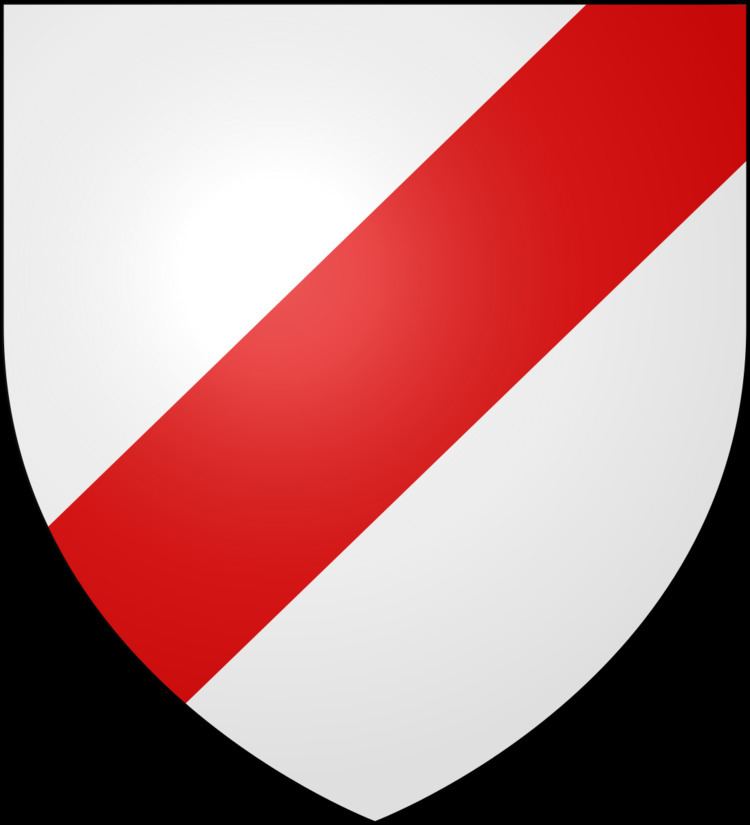 | ||
In heraldry, a bend is a band or strap running from the upper dexter (the bearer's right side and the viewer's left) corner of the shield to the lower sinister (the bearer's left side, and the viewer's right). Authorities differ as to how much of the field it should cover, ranging from one-fifth (if shown between other charges) up to one-third (if charged alone). The supposed rule that a bend should occupy a maximum of one-third of the field appears to exclude the possibility of two or three bends being shown together, but contrary examples exist. Outside of heraldry, the term "bend (or bar) sinister" is sometimes used to imply ancestral illegitimacy.
Contents
Modified bends
A bend can be modified by most of the lines of partition, such as the bend engrailed in the ancient arms of Fortescue or in the more modern examples of Cleethorpes Borough Council, England, and the bend wavy in the ancient coat of Wallop, Earls of Portsmouth of the modern Picard, Canada.
Bend sinister and "bar sinister"
The usual bend is occasionally called a bend dexter when it needs to contrast with the bend sinister, which runs in the other direction, like a sash worn diagonally from the left shoulder (Latin sinister means left).
The bend sinister and its diminutives such as the Baton sinister are rare as an independent motif; they occur more often as marks of distinction, added to another coat to denote bastardy. For example, Arthur Plantagenet, 1st Viscount Lisle (d.1542), illegitimate son of Edward IV of England, bore the arms of the House of York with a bendlet sinister overall.
It appears in more modern examples such as the arms of Lincolnshire County Council, England, and The Corporation of the Township of McNab/Braeside, Canada.
In French blazon a bend sinister is called a barre. Sir Walter Scott is credited with giving literature the macaronic phrase bar sinister, which has become a metonymic term for bastardy. In English blazon a bar is a horizontal stripe, symmetric with respect to sinister and dexter. (Bar and barre are pronounced alike.)
Though its stripe runs in the opposite direction (heraldically dexter rather than sinister) the modern ISO No symbol, consisting of a red circle with a red diagonal stripe, performs a function analogous to a mark of distinction in modern signage, indicating that whatever it overprinted on is prohibited (e.g. No Smoking ).
Diminutive forms
The diminutives of the bend, being narrower versions, are as follows, in descending order of width:
In bend
The phrase in bend refers to the appearance of several items on the shield being lined up in the direction of a bend, as in the arms of the ancient Northcote family of Devon: Argent, three crosses-crosslet in bend sable. It is also used when something is slanted in the direction of a bend, as in the coat of Surrey County Council, England.
Bendwise
A charge bendwise is slanted like a bend, as in the Canadian coat of Barry Lereng Wilmont. When a charge is placed on a bend, by default it is shown bendwise, as in the coat of Wilmslow Urban District Council, England.
Party per bend
A shield party per bend (or simply per bend) is divided into two parts by a single line which runs in the direction of a bend, as in the coat of Michael George Levy. Applies not only to the fields of shields but also to charges.
Bendy
Bendy is a variation of the field consisting (usually) of an even number of parts, most often six; as in the coat of the duchy of Burgundy.
Analogous terms are derived from the bend sinister: per bend sinister, bendwise sinister, bendy sinister.
